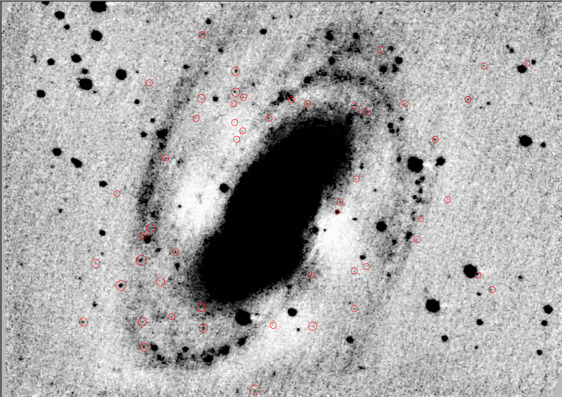Messier 81 is the nearest large spiral galaxy outside the Local Group and gives its name to the M81 group of galaxies and is 3.7 megaparsecs away from us. It is roughly half the size of the Milky Way and has roughly half the number of globular clusters, perhaps 125 compared with the 200 or so in our galaxy. At that distance the globular clusters look like faint stars and careful image processing is needed to make them easily visible. Large professional telescopes are needed to distinguish them from foreground stars in our galaxy. Julie B. Nantais and John P. Huchra published Spectroscopy of M81 Globular Clusters in 2010 which included a catalogue of the positions and magnitudes of 107 globular clusters in M81. This catalogue was used to locate the globular clusters marked on the images below.

As in our galaxy, the globular clusters around M81 are generally found far away from the galactic core, though perspective can make them appear to be close in. The core is bright and the clusters are faint, so the contast stretching needed to make them visible results in the body of the galaxy being severely over exposed (though this can be overcome to some extent as will be seen later). It is markedly easier to see small faint objects in a negative image, where the stars and clusters are black against a white sky. In this first image 49 globular clusters are marked out of a total of 107 in the catalogue. The missing ones are either too faint to be picked up, lost in the background glare from the galaxy itself, obscured by brighter stars and emission nebulae (H-II regions), or out of the field of view. The brightest is magnitude 17.53 and the faintest 20.90.
After creating that image I realised that if the light from the galaxy could be removed there might be a chance of seeing some more globular clusters. Accordingly another image was created by blurring the original with a 25-pixel radius median filter. That smoothed image was subtracted from the original, thereby removing almost all of the gently varying intensity, leaving only the fine details. The somewhat bizarre looking result appears below. Stars are clearly visible, as are the lines of H-II regions which delineate the spiral arms. Crucially the globular clusters are still visible, including a fair number which were previously hidden. The newcomers are circled in red. The two in yellow are the pair which were closest to the center of the galaxy which could be seen in the top image.

| Date and time of observation | 2019-03-11 02:00 UT |
| Telescope | 0.4m f/6.5 Dilworth-Relay |
| Camera | SBIG-8X CCD |
| Filter | None |
| Exposure | 239×30s (7170s total) |
| Centre of image | RA 9h55m30.6s Dec +69°03'50" |
| Image dimensions | 13.3 arcmin × 9.4 arcmin |